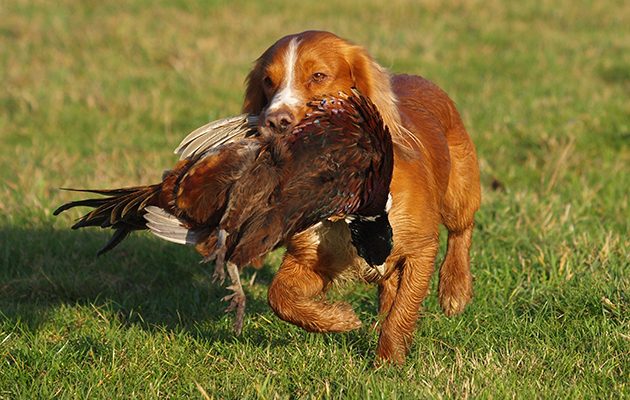Our smallest spaniel breed is hugely popular among readers, says Field Gundog Awards judge David Tomlinson. However, this popularity is not without its downside
Today the cocker spaniel is a popular gundog, often outnumbering springers in the field. And it is easy to see why. Cockers have courage and character and their small size makes them more suitable house dogs. But this popularity comes with its problems, warns David Tomlinson. Do your homework and consider cocker spaniel health problems before acquiring one.
Crossbreeds are generally healthier than the pedigrees and more and more are turning up in the line. But do they perform as well? Read crossbreed gundogs: the day of the crossbreed?
WORKING COCKER SPANIEL HEALTH PROBLEMS
Judging The Field’s gundog awards last summer was not only a reminder of the high esteem in which readers of this magazine hold their dogs (even the naughty ones) but of the growing popularity of the cocker spaniel. As I mentioned in my report on the awards (December issue), there were numerous cockers entered into every class for which they were eligible. Cockers may be small but they are dogs with character, not to mention a passion for sport that is at least the equal of any of our other gundog breeds.
Historians will tell you that for much of the 19th century, most our sporting spaniels were essentially the same type. Big individuals would be called field spaniels, smaller ones cockers, so you could get both types in one litter. The general divide was a weight of 25lb. Give your 24lb cocker a good dinner and it could become a field spaniel overnight.
All this changed in 1893, when the Kennel Club finally allowed the cocker to gain its place in the stud book as a separate breed; the Cocker Spaniel Club was founded nine years later. The Club still flourishes today, with membership up from its initial 35 to more than 1,500. In the early days its mission was promoting the breeding of cockers but in a subtle change of words it now promotes the well being of these spaniels. Health is a major issue. Sadly, it’s probably true to say that cockers are less healthy today than they were a century ago, chiefly due to selective breeding leading to loss of genetic diversity.
In a little over a century, the breed has had its ups and downs. In 1930, HS Lloyd won best in show at Crufts with his blue-roan cocker dog, Luckystar of Ware, repeating the feat the following year. In 1938 and 1939, Lloyd achieved a second double with his bitch Exquisite Model of Ware and he did it again in 1948 and 1950 with Tracey Witch of Ware. In post-war Britain the cocker became our most popular breed of pedigree dog, with 27,000 puppies registered in 1947.
Sadly, popularity as a pet and success in the show ring didn’t do the working cocker any favours and by the ’60s it was becoming increasingly difficult to find a genuine working cocker with both drive and ability. This led to an unofficial introduction of springer spaniel blood, which went a long way to reviving the fortunes of a fading breed. Slowly but surely the cocker recovered its reputation as a genuine alternative to the ubiquitous English springer. Today, the cocker has reached a highpoint as a working gundog, often outnumbering, even replacing, the springer on many shoots.
SELECTIVE BREEDING
Selective breeding has also led to more biddable cockers, so it’s not unusual to see them employed as peg dogs, though it does take a good trainer to persuade a cocker to sit untethered by a peg. Many pickers-up have added a cocker to their retriever team, for a cocker can go where labradors fear to tread. But it’s in the beating line that they come into their own, hunting fearlessly with enormous zest and enthusiasm.
Thus it’s not difficult to explain their popularity but there are some other factors, too. Their size makes them easy to live with: I have a sneaking suspicion that the majority of working cockers live indoors. They are great family dogs and being less than half the size of a labrador eat proportionately less and are not so inclined to get fat, either. They come in a greater variety of colours than any other gundog breed, with roans, bicolours, particolours, tricolours and solids to choose from. It’s not unusual to get four or five different colours in a litter of cockers.
However, the current popularity of the working cocker has its downside. Popular working sires, most notably those that have been successful as trialling dogs, have been used far too often at stud. It’s normal to look at a cocker pedigree and see the same stud dog’s name appear on both the sire’s and the dam’s sides of the page. The COI (coefficient of inbreeding) gives an accurate indication of how inbred a dog is. The average for the cocker in the UK is 9.6% but there are many working dogs with a higher figure than this.
Another worry is EPS: effective population size. EPS is a measure of how many individuals are contributing genetically to a breed population and the size of the gene pool. Anything below 100 is considered critical by conservationists, while a figure below 50 threatens the future of the breed. The figure for the cocker is a deeply worrying 49.10; the EPS for the labrador is 114.
So if you are considering acquiring a working cocker, do your homework before you buy. Unless you are planning to trial your puppy look for one that hasn’t got too many field-trial champions in its pedigree. Check the COI of the puppy’s sire and dam, something that is easy to do on the Kennel Club’s website. And if you are not planning to compete with your dog, why not consider a sprocker, a springer x cocker cross?





